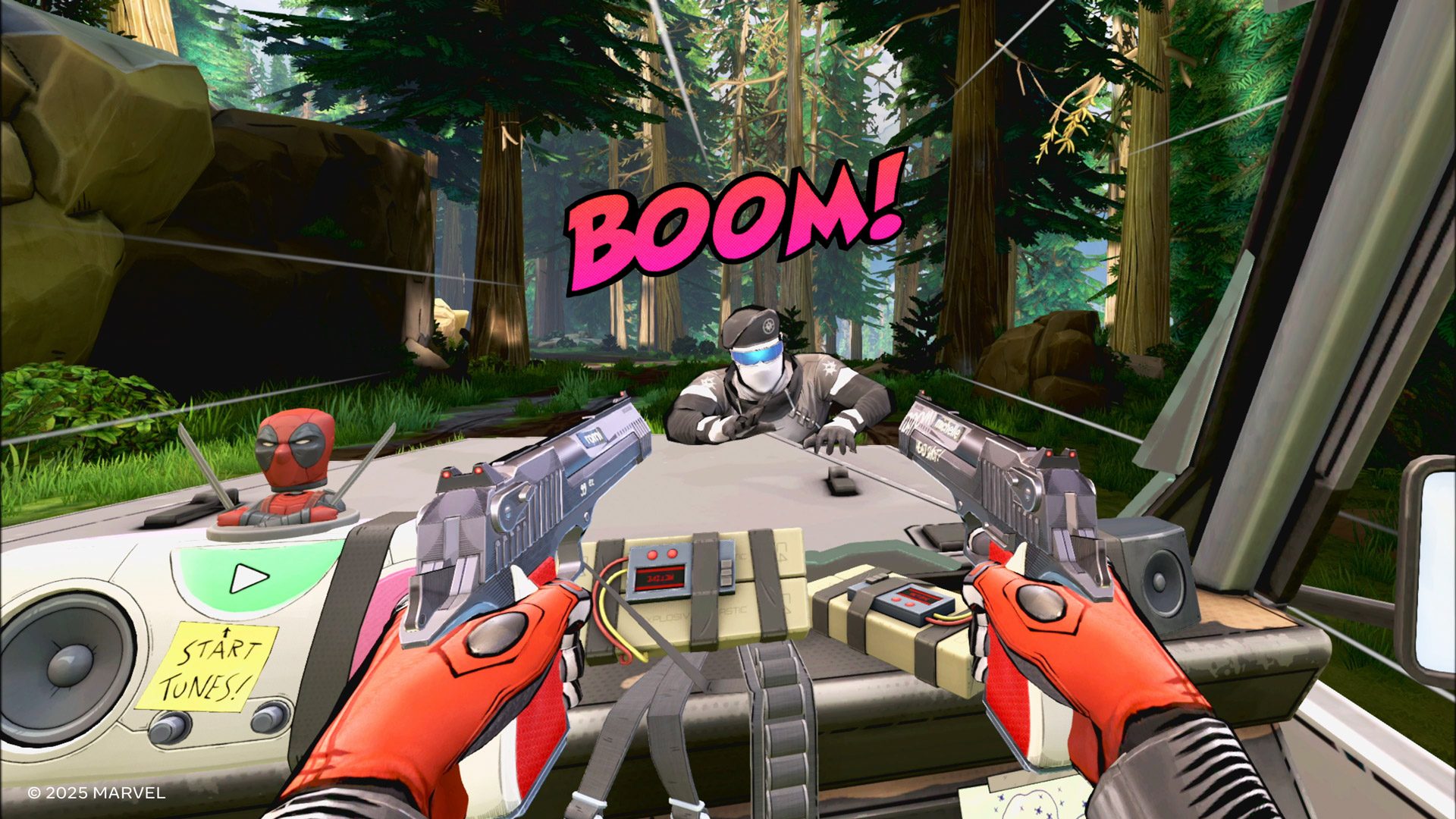We got an early look at Marvel’s Deadpool VR, the upcoming title from first-party Meta studio Twisted Pixel.
You can see our coverage of the game’s announcement, but here’s the deets: Deadpool VR is being developed by Twisted Pixel and planned for release later this year. The game will be exclusive to Quest 3 and Quest 3S. Check out the trailer for an idea of the gameplay.
I recently met with Meta and Twisted Pixel to go hands-on with an early version of Deadpool VR and found that the game has strong visuals and understands the Deadpool ‘vibe’, but it feels like there’s a lot of tuning left to do to make the combat and VR interactions satisfying and enjoyable.
After the high bar set by both Iron Man VR and Batman Arkham Shadow, I went into the Deadpool VR demo ready to have fun with another superhero VR game.
Starting off with the good stuff, the game’s visual presentation is an obvious strong point. The screenshots in this article don’t do it justice; the cel-shaded look fits well with both the game’s style and the limitations of a standalone headset. The overall art direction is clearly on point, with a cohesive look throughout. Deadpool VR was sharp and ran smoothly throughout my entire time playing the game.
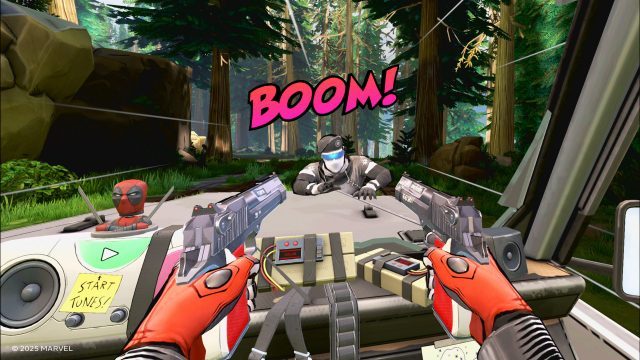 Twisted Pixel has also done a good job of capturing the essence of Deadpool in the game. Neil Patrick Harris (well known as both a face and voice in film, TV, and videogames) as the voice feels like a great fit for Deadpool’s sarcastic, fourth-wall breaking energy. And the writing for the character feels on-point too.
Twisted Pixel has also done a good job of capturing the essence of Deadpool in the game. Neil Patrick Harris (well known as both a face and voice in film, TV, and videogames) as the voice feels like a great fit for Deadpool’s sarcastic, fourth-wall breaking energy. And the writing for the character feels on-point too.
As for the gameplay, Deadpool VR is positioned as an action shoot-’em-up (and stab’em-up), and Twisted Pixel says it has gone to lengths to make an exciting and dynamic combat sandbox full of fun and zany mechanics. ‘If you think you can, try it’ was a mantra the dev team repeated on several occasions, highlighting its efforts to reward player creativity.
Indeed, there’s plenty of tools at your disposal. Just in the demo I was able to wield pistols, shotguns, SMGs, dual katanas, grenades, and a grappling hook. And there’s sliding, wall-running, jump-kicking, and grappling as both means for movement and attack.
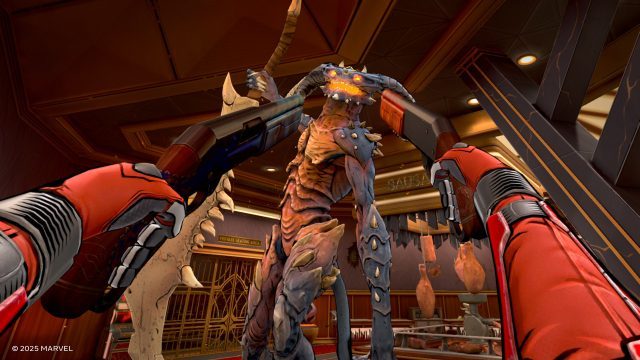
In theory this all should make for stylish and fun gameplay, but there’s something that’s not landing for me when it comes to the overall game-feel.
Guns feel reasonably good upon pulling the trigger (in particular, I like the way recoil feels), but in an effort to streamline the combat, there’s no hands-on interactions with the weapons. It’s really just point-and-shoot. If a weapon does reload, it happens automatically after the whole clip is spent.
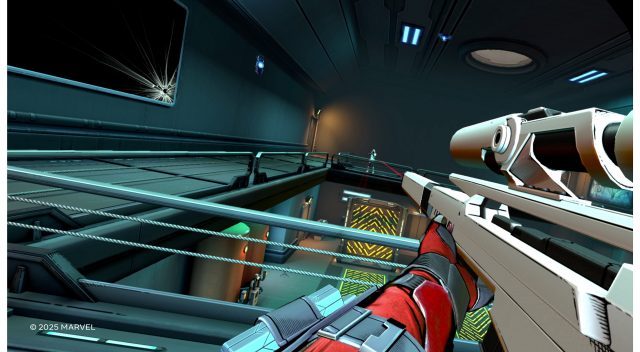
But hey, I get it. There’s a lot more going on and the studio clearly wanted to make the weapons simple on purpose so players can more easily put the rest of their tools to use.
So out come the katanas… what could be more badass?! Of course the first thing you’re going to try to do when you pull out two sick samurai swords is clang them together to strike fear into your enemies! Except you can’t because the blades phase through each other. And listen, I get it, Deadpool VR is an arcade-y action game, not a sim. But other arcade-y VR games with swords, like Until You Fall, let you clang and grind your blades together in an oh-so-satisfying way.
That was my first clue that the melee combat needs some extra attention. Maybe this is simply a tutorial issue, but as far as the game’s feedback showed, it was unclear if it wanted players to primarily stab or slash with the swords. One seemed to work better than the other at different times (perhaps on an enemy-to-enemy basis?). Beyond that, so much of the combat relies on artificial motion using your thumbstick that attacking with the swords feels more like ‘jousting’ by using the stick to glide toward enemies instead of really swinging your swords at them. Fighting this way doesn’t deliver the ‘sword wielding fantasy’ very effectively.
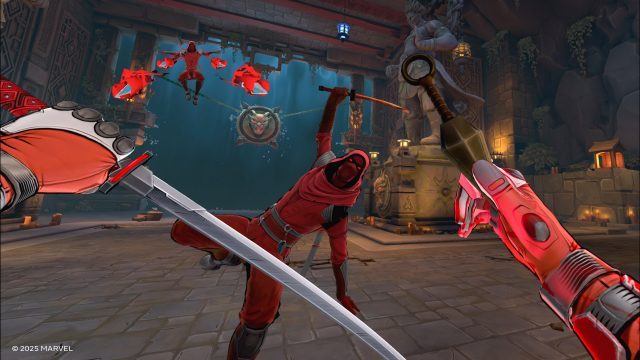
Perhaps this is just a tutorialization issue. The demo had some tutorials to show the player what was expected, but maybe the full game will have clearer tutorials (or things will become more apparent with more playtime).
But then there’s the details that don’t feel quite right in VR. Like when throwing a katana into an enemy and it sticks into their body, but I can’t walk up to them and pull it back out (instead it just respawns on my back). Yet, you can pull your katana out of a stabbed enemy if you stab them up close (instead of throwing your blade).
There were numerous inconsistencies like this. Another one that stood out to me was when I tried to activate a big red button by pressing it with the heel of my pistol. After two tries and the button not responding, I holstered my pistol, then pressed the button again with my hand… which caused it to respond as expected.
In 2025, this kind of ‘attention to interaction consistency’ is largely considered table stakes for a serious VR game, even if it isn’t a heavily ‘sim’ focused title. Without it, a game starts to feel like it was designed for a flatscreen before being ported to VR.
The thing that really stood out to me after my time in the demo was that, on paper, Deadpool VR has a fun and dynamic combat sandbox. But it didn’t manage to feel even as good as something like Robo Recall, another VR action-arcade game which is now more than eight years old.
Granted, Twisted Pixel mentioned outright that it knows it still has a lot of mechanical polish to do, especially when it comes to melee. I’m hopeful that in the time between now and the ‘later this year’ release, the game will get a significant tuning pass to close the gap between the quality of its presentation and the feel of its gameplay.
,
